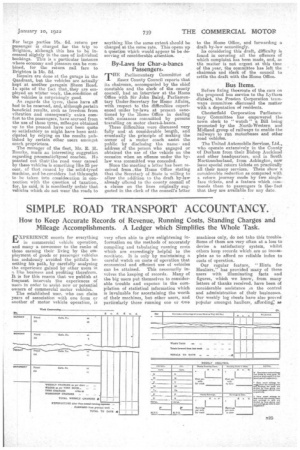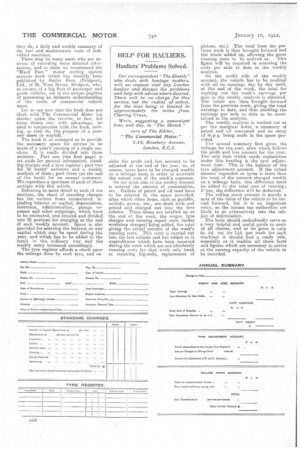SIMPLE ROAD TRANSPORT ACCOUNTANCY.
Page 23

Page 24

If you've noticed an error in this article please click here to report it so we can fix it.
How to Keep Accurate Records of Revenue, Running Costs, Standing Charges and Mileage Accomplishments. A Ledger which Simplifies the Whole Task.
EXPERIENCE counts for everything in commercial vehicle operation, and many a newcomer to the ranks of those earning their living by the employment of goods or passenger vehicles has sedulously avoided the pitfalls besetting his path, by carefully analysing the experience gained by other users in a Ube business and profiting therefrom. It is for this reason that we publish at frequent intervals the experiences of users in order to assist new or potential owners of commercial motor vehicles. The established user. who can claim years of association with one form or another of motor vehicle operation, is very often able to give enlightening information on the methods of accurately compiling and tabulating running coats which are exceedingly helpful to the novitiate. It is only by maintaining a careful watch on costs of operation that economical and efficient use of vehicles can be attained. This necessarily involves the keeping of records, Many of the big users put themselves to considerable trouble and expense in the compilation of statistical information which is invaluable for ascertaining the worth of their machines, but other users, and particularly those running one or two
machines only, do net take this trouble. Some of them are very often at a loss to devise a satisfactory system, whilst others keep records which are so incomplete as to afford no reliable index to casts of operation.
Our regular feature, " Hints for Hauliers," has provided many of these users with illuminating facts and figures, which we know, from many letters of thanks received, have been of considerable assistance in the control and administration of ,their businesses. Our weekly log sheets have also proved popular amongst hauliers, affording; as
they do a daily and weekly summary of the fuel and maintenance costs of individual machines.
There may be many users who are desirous of recording more detailed information, and to them we recommend the "Hard Fact" motor costing system account book which has recently been published by Butler Bros. (Bridport), Ltd., of 26, West Street, Bridport, who, as owners of a big fleet. of passenger and goods vehicles, are in the unique polition of possessing an intimate understanding of the needs of commercial vehicle users.
Let us say now that the book does not clash with The Commercial Motor log sheets; quite the reverse, in fact, for these sheets can, with advantage, be used in conjunction with the book, serving, as they do, the purpose of a journey sheet or waybill The hook is so arranged as to provide the necessary space for entries to be made of a y a ear's running of made of a y a ear's running of
i single machine. It s really divided into three sections. "Part one (the first page) is set aside for general information, standing charges and a tyre register; part two for 52 weeks' accounts and a weekly analysis of them.; part three (at the end of the book) for an annual summary. We reproduce a specimen of each of these sections with this article.
Referring in more detail to each of the sections, the chart of standing charges has the various items enumerated, including interest on capital, depreciation, insurance administration, garage expenses and other outgoings, which have to be estimated, and entered and divided into 52 portions for charging at the end of each weekly account. Space is also provided for entering the interest on any capital which may be spent during the year, and which has to be added to the totals in the ordinary way and theweekly entry increased accordingly. The tyre register affords a check upon the mileage done by each tyre, and en abIes the profit and loss account to be adjusted at the end of the year, as, of course, tyres have to be charged weekly on a mileage basis in order to ascertain the actual cost of the week's expenses.
On the debit side of the weekly account is entered the amount of consumables, etc. Gallons of petrol and oil used have to be entered in the space provided, after which other items, such as paraffin, carbide, grease, etc., are dealt with and priced and charged out into the first column. These•items are totalled up at the end of the week, the wages, tyre charges and running repair costs (under workshop charges) being added, the total giving the actual amount of the week's running costs. This total is carried out into the last column and has added to it expenditures which have been incurred during the week which are not absolutely running costs for that week only (such as repairing big-ends, replacement of pistons, etc.). The total from the previous week is then brought. forward and the whole added up, allowing the gross running costs to be arrived at. This figure will be required in assessing the costs per mile to date in the weekly analysis. On the credit side of the weekly account, the vehicle has to be credited with all its earnings day by day until, at the end of the week, the total for working out the week's earnings per mile in the weekly analysis is obtained. The totals are then brought forward from the previous week, giving the total earnings to date, and thus enabling the earnings per mile to date to be ascertained in the analysis.
The weekly analysis is worked out as per the marginal notes, a summary of petrol and oil consumed and an entry of m.p.g. being made in the space provided.
The annual summary first gives the mileage for the year, after which follows the profit and loss account for the year. The only item which needs explanation under this heading is the tyre adjustment item. This is the balance of the tyre adjustment account. If the actual amount expended on tyres is more than the total of the amount charged weekly on a mileage basis, this difference must he added to the total cost of running; if less, the difference will be deducted.
The rolling stock account. is merely a note of the value of the vehicle to be carried forward, but it is an important entry, as the income tax authorities are likely to go exhaustively into the subject of depreciation.
The book should undoubtedly serve as a very helpful and useful guide to users of all classes, and as its price is only 6s. 6d. net (or 1_0. per week for each machine) it should find a ready sale, especially as it enables all those facts and figures which are necessary to arrive at the earning capacity of the vehicle to be recorded.


































